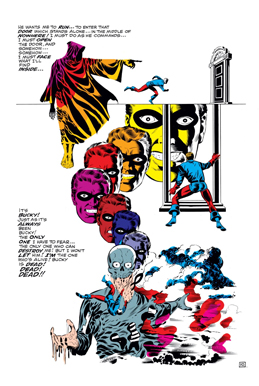
It isn’t uncommon for young people to become bored or
unfulfilled with their first career.
After all, it is during that first career that we learn to refine our
strengths and reverse, or at least identify, our weaknesses. Often, during that process, one realizes that
the original career has been outgrown and new challenges are desired.
Now, imagine that your first career is that of escape
artist. Yes, just like Houdini or
someone. In addition to that pursuit,
you also dabble in magic and fire eating.
Yet, somehow that isn’t enough; the niche you seek is still elusive. So, you become a musician, a rock and roll
guitarist, even befriending early rockers like Bill Haley, and that still
doesn't seem to be it.
Then, one day, after experimenting with some free-lance work
as an artist for an advertising agency and a third-rate comic book company, you
are approached by the publisher of the fastest growing, and increasing popular,
“intellectual” comic book company, Marvel.
Suddenly, being an escape artist seems rather bland.

It was as if someone handed Jim Steranko a multi-million
dollar toy. He served as an assistant to
some of the leading, and most innovative, comic book artists of the 1960’s, was
given a rather minor title on which to work as both artist and writer, and then
took comic book art and storytelling to a level that had not been
imagined. Although it may not seem so to
those who have never experienced high-minded graphic novels and their manner of
re-working and re-imagining classic archetypes and tropes, the moment that comics
made a jump into the realm of literature was with the advent of Steranko in the late 1960's.
[Steranko's story may sound familiar to those who read Michael Chabon's novel, The Adventures of Kavalier and Clay, which was on the New York Times' list of bestsellers and won the Pulitzer Prize for fiction back in 2001; Steranko was the inspiration for one of the protagonists. Clearly, I'm not the only one to find his life and art interesting.]
[Steranko's story may sound familiar to those who read Michael Chabon's novel, The Adventures of Kavalier and Clay, which was on the New York Times' list of bestsellers and won the Pulitzer Prize for fiction back in 2001; Steranko was the inspiration for one of the protagonists. Clearly, I'm not the only one to find his life and art interesting.]

While he started cautiously, he soon began to take elements
from the burgeoning synthesis of surrealism and op-art, images familiar to the fans of Peter Max and Andy
Warhol, and created something that had never been seen before. Even to an eleven-year-old member of the
Marvel fan club, it was clear that, as innovative as those comics had been,
this was something shockingly new. What
was a minor title became a sensation; and its artist the one that was always
sought out at the corner pharmacy’s comic book section.
He didn’t stay with one comic title very long, but continued
to serve as an artist, writer, and inspiration to all subsequent writers and
artists in the milieu. The reason that
he remains in my memory is that he revealed just how accessible art in all of
its forms could be; and how an embrace of the new could inform even the most tired
of forms.
More of him may be read and, more importantly, seen at this website.